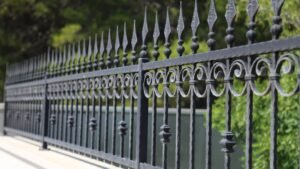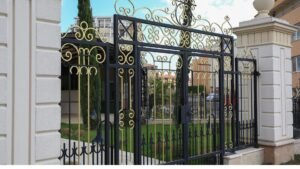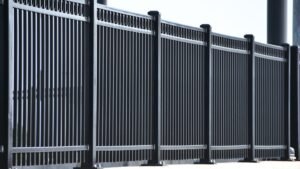Welcome to our comprehensive guide on how much it costs to install a fence gate. Whether you’re looking to enhance your home’s security, improve privacy, or simply add a stylish entry point to your property, understanding the costs involved is crucial. The price can vary widely depending on factors like the material you choose, the size and style of the gate, and whether you opt for professional installation or take the DIY route. In this article, we’ll break down everything you need to know, from material and labor costs to additional factors like permits and automation, so you can make an informed decision and plan your budget with confidence.
On average, the cost to install a fence gate ranges from $200 to $4,000, depending on the material, size, and type of gate. Basic chain-link gates can cost as little as $50 to $400, while more durable options like wood or metal gates range from $300 to $4,000 or more. Labor costs typically add $30 to $75 per hour, with more complex installations, such as automated gates, potentially raising the overall cost to $7,000 or more.
Table of Contents
Why Install A Fence Gate?
Installing a fence gate is an excellent investment for any homeowner. Not only does it serve a functional purpose, but it also enhances the overall look and value of your property. Here are a few key reasons why adding a fence gate can be a smart move.
1. Security and Privacy
One of the primary reasons people install fence gates is to boost the security and privacy of their homes. A well-constructed gate acts as a physical barrier, helping to keep unwanted visitors off your property. Whether you’re trying to keep out intruders or simply want to prevent animals from wandering in, a fence gate is a practical solution. By adding this layer of protection, you can feel more secure in your home.
Privacy is another critical factor. A properly installed gate keeps your home and yard shielded from prying eyes, allowing you to enjoy your outdoor spaces without feeling exposed. Whether you’re relaxing in the garden, hosting a backyard barbecue, or just spending time with family, a fence gate can help maintain your privacy and peace of mind.
2. Aesthetic Appeal and Property Value
Beyond security, a fence gate can significantly enhance the aesthetic appeal of your home. The right design can complement your landscaping and architecture, giving your property a polished, cohesive look. A thoughtfully chosen gate—whether it’s modern, traditional, or rustic—can create a stunning first impression and add curb appeal that catches the eye of visitors and potential buyers.
Moreover, investing in a well-installed gate can boost your property value. Homes with attractive fencing and gates are often perceived as more secure and well-maintained, which can make them more desirable in the real estate market. Whether you’re planning to sell your home in the near future or simply want to make a long-term investment in your property, a fence gate can help elevate both its visual and financial appeal.
3. Functionality
Fence gates aren’t just about looks and security—they also offer practical benefits. Depending on your needs, gates can be customized for various functionalities. Automated gates, for example, provide the convenience of hands-free access. Whether you’re driving home or hosting guests, you won’t have to manually open the gate every time. These gates also offer added safety, especially if you have children or pets, as they allow you to control who enters and exits the property with ease.
For homes with large backyards, a fence gate offers easy access to outdoor spaces. Whether you’re moving gardening tools, entertaining guests, or just heading out for some fresh air, having a well-placed gate makes movement between spaces seamless and convenient.
In summary, installing a fence gate offers multiple benefits—improved security, enhanced privacy, aesthetic value, and increased functionality. Whether you’re aiming for better protection, a boost in property value, or simply more convenient access to your home, a fence gate is a worthwhile addition that brings long-term advantages.

Breakdown Of Costs
When planning to install a gate on your property, understanding the breakdown of costs is essential. This section will explore the two key factors that influence the total expense: material costs and labor costs. Whether you’re looking for something budget-friendly or a more luxurious option, having a clear view of these expenses will help you make an informed decision.
Material Costs
The type of material you choose for your gate significantly affects both the initial cost and long-term maintenance expenses. Here’s a detailed look at the most common options:
Wood Gates:
- The cost for wood gates ranges from $100 to over $1000, depending on the type of wood, size, and design complexity. Wood gates are a popular choice for their natural, aesthetically pleasing appearance and the ability to customize them. However, they do require regular maintenance, such as painting or staining, to prevent damage from weather and insects.
Metal Gates (Iron, Aluminum, Steel):
- Metal gates, depending on the material, typically range from $200 to $4000 or more. Iron gates are known for their strength and security but can be prone to rust if not properly maintained. Aluminum gates, while lighter and resistant to rust, can dent more easily. Steel gates offer a middle ground, balancing durability and resistance to wear. Overall, metal gates are an excellent choice for security and longevity, though they can come at a higher cost.
Vinyl Gates:
- Vinyl gates range from $200 to $2000+. These gates are becoming increasingly popular due to their low-maintenance properties and resistance to weathering. Vinyl gates require little to no upkeep and tend to last longer than wood, making them a practical option for homeowners seeking durability without the hassle of regular maintenance.
Chain-Link Gates:
- Chain-link gates are the most affordable option, ranging from $50 to $400+. These gates are practical for functional needs, such as enclosing a yard or creating a secure area for pets. While they aren’t as visually appealing as wood or metal gates, they are a cost-effective and durable solution.
Labor Costs
Labor is another crucial factor that influences the overall cost of gate installation. Whether you choose to hire a professional or tackle the installation yourself, understanding labor expenses is key.
Hourly Rates for Professional Installation:
- The average hourly rate for professional gate installation varies between $30 and $75, depending on the region and the complexity of the installation. Larger, more intricate gates will likely require more time and labor, increasing the total cost. It’s also essential to consider that specialized materials, like iron or custom woodwork, may require installers with specific skills, which could raise labor costs.
DIY vs. Hiring a Professional:
- Opting for a DIY installation can save you money on labor, but it requires a significant investment of time and skill. Unless you’re experienced with gate installations, it can be challenging to ensure that everything is level, secure, and correctly fitted. Mistakes made during a DIY installation can lead to additional costs for repairs or adjustments down the line.
- On the other hand, hiring a professional installer ensures a high-quality job, often with a warranty on the work. Professionals can complete the installation quickly, minimizing disruption to your home. While the upfront cost might be higher, the assurance of a well-installed gate that operates smoothly can be worth the investment in the long run.
Understanding both material and labor costs will allow you to budget more effectively for your gate installation project, ensuring that you get the best value for your money while achieving the functionality and aesthetic you’re after.
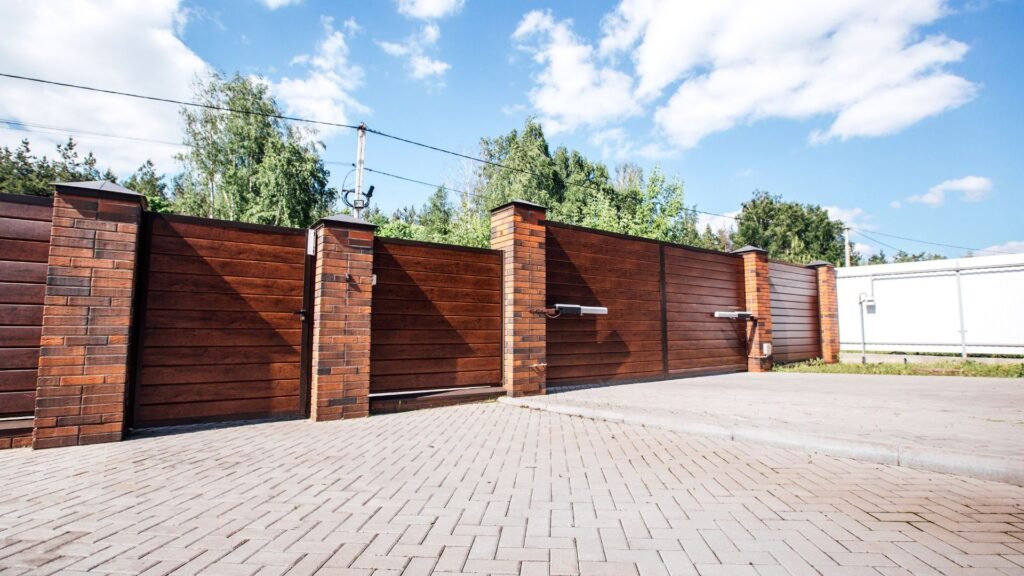
Additional Cost Factors
When planning for gate installation, understanding the variety of factors that can impact the overall cost is crucial. Beyond the gate material and basic installation fees, there are several additional cost factors to consider that could significantly affect your budget. Below is a detailed breakdown of these factors to help you make an informed decision.
Size and Style of the Gate
Single vs. Double Gates
One of the most important decisions when installing a gate is whether to opt for a single or double gate. Single gates are typically smaller, which makes them more affordable in both materials and labor. On the other hand, double gates—often used for larger entrances—require more materials and craftsmanship, which can increase the overall price. Double gates provide a more impressive aesthetic but can add hundreds to thousands of dollars to your budget depending on the design and materials used.
Custom Designs
If you’re considering adding a personalized touch to your gate, keep in mind that custom designs come with higher costs. Intricate shapes, patterns, or artwork on your gate may require specialized manufacturing techniques or materials, which naturally increases expenses. A basic gate might meet your functional needs, but a custom design can elevate the aesthetic appeal of your property, making it an investment in both security and curb appeal. However, the more elaborate the design, the higher the price, sometimes adding several thousand dollars to your installation costs.
Automation (Electric Gates)
Costs of Motorized Gates
Automated gates offer the convenience of easy access without the need to manually open and close the gate, but this convenience comes at a price. The cost of motorized gates can range significantly, from $850 for a basic system to over $5000 for a high-end, sophisticated setup. The price range depends largely on the type of automation system you choose—whether it’s a sliding gate, swing gate, or something more complex. Additionally, you’ll need to factor in the costs of wiring, sensors, and control systems to ensure the gate functions smoothly.
Maintenance of Automated Gates
Automated gates aren’t just a one-time expense. Over time, you’ll need to budget for regular maintenance, repairs, and even part replacements. Motorized systems involve electrical components that require servicing, and depending on the complexity of the system, these costs can add up. Neglecting maintenance can lead to bigger repair issues down the road, so planning for this in your ongoing budget is essential.
Location and Permits
Permits and Local Regulations
Before you break ground on your gate installation, it’s important to check your local regulations. Many areas require permits for gate installations, especially if the gate includes an automated system or stands over a certain height. Permit costs vary by region but typically fall between $50 and $200. Skipping this step can result in hefty fines or the requirement to remove your gate altogether, so it’s best to budget for any necessary permits upfront.
Geographical Variations in Labor Costs
Location plays a key role in determining labor costs for gate installation. Labor is generally more expensive in urban areas where the cost of living is higher. In contrast, rural areas may offer lower labor rates, but other factors, such as the availability of skilled laborers, can impact the final price. It’s always wise to get multiple quotes to compare prices based on your specific location.
Ground Conditions
Soil Quality and Slope
The terrain of your property can greatly influence the complexity—and cost—of gate installation. If your land has rocky soil, clay, or a steep slope, extra effort and equipment may be required to prepare the ground. A flat, even surface allows for easier installation, whereas challenging ground conditions may require more labor, specialized equipment, or even additional materials to ensure the gate is properly secured.
Extra Preparation
In some cases, the land itself may need to be leveled, or obstructions like tree roots and large rocks might need to be removed. These additional preparations can increase your overall cost, as they often require professional grading or excavation services. Depending on the extent of the work, this can add several hundred to thousands of dollars to your project. It’s wise to assess the ground conditions before beginning your installation to avoid unexpected expenses later on.
Understanding these additional cost factors will help you budget more accurately for your gate installation. By planning for aspects such as gate size, style, automation, and ground preparation, you can avoid unpleasant surprises and ensure that your new gate enhances both the functionality and aesthetic of your property without breaking the bank.

Real-Life Examples Of Fence Gate Installation Costs
Understanding the actual costs involved in fence gate installation can help homeowners better plan their budget. Here, we’ll dive into three real-life examples of different types of fence gates, ranging from a simple wooden gate to a more complex motorized iron gate, and even a budget-friendly chain-link option. Each example includes the total cost, a breakdown of materials and labor, and what you can expect when planning your own project.
Example 1: A Standard 4-Foot Wood Gate
A typical wooden gate installation can be a straightforward project for homeowners looking for an affordable and classic option. The overall cost for a 4-foot wooden gate usually falls between $500 and $1200, which covers both materials and labor.
- Total cost: $500 – $1200, including both materials and labor.
- Materials cost: Approximately $300. This cost includes the wood, hinges, screws, and other hardware needed to install the gate.
- Labor cost: $200 – $600, depending on the complexity of the installation and local labor rates. If you’re hiring a professional to install your wooden gate, labor costs will vary, but typically, it represents a significant portion of the overall expense. The installation may take a few hours, and contractors usually charge by the hour or offer a fixed price.
Example 2: A Motorized Iron Gate
A motorized iron gate is a more upscale and secure option that is perfect for homeowners looking to increase both functionality and curb appeal. Due to its complexity and the high cost of automation, motorized gates tend to be a more expensive investment.
- Total cost: $2000 – $7000+, depending on the type of automation system and the size of the gate.
- Materials cost: Around $1500. Iron is a durable and strong material, and the cost of materials also includes other essential components like tracks and posts.
- Labor cost: $500 – $2000. Labor for installing an iron gate can be more intensive due to the weight and complexity of the material. If your project includes features like an automatic opener or additional security systems, labor costs will likely be on the higher end.
- Automation cost: An additional $1000 or more. The automation system, which includes motors, sensors, and control panels, is a major cost factor for motorized gates. Higher-end systems with remote access or smartphone compatibility can push costs even higher.
Example 3: A Chain-Link Gate for a Backyard Fence
For homeowners looking for a functional and cost-effective option, a chain-link gate can be a great choice. These gates are simple, durable, and affordable, making them ideal for backyard or garden fences.
- Total cost: $150 – $600, depending on size and labor.
- Materials cost: Around $100. Chain-link gates are typically made from galvanized steel, which is resistant to rust and wear, making it a low-maintenance option.
- Labor cost: $50 – $300. Labor costs for a chain-link gate can vary, but this is an installation that many homeowners may choose to do themselves, further reducing the total expense. However, if you choose to hire a contractor, the labor cost will depend on how complex the installation is and the size of the gate.
When planning a fence gate installation, it’s important to consider the type of gate that best suits your needs, your budget, and the level of security or aesthetic appeal you’re aiming for. Whether you’re going for a simple wood gate, a high-tech motorized iron gate, or a budget-friendly chain-link option, each type comes with its own cost considerations. By breaking down the expenses into materials and labor, you’ll have a clearer picture of what to expect and can make an informed decision that balances cost and functionality.

How To Save Money On Fence Gate Installation
When it comes to fence gate installation, there are several smart strategies you can use to save money without compromising on quality. Whether you’re installing a gate for privacy, security, or aesthetics, here’s how you can reduce costs while still achieving a durable and effective result.
1. Comparison Shopping
One of the best ways to save on installation costs is to get quotes from multiple contractors. Different companies may offer different pricing for the same job, so it’s important to do your research. Reach out to several local contractors, compare their estimates, and ask questions about what’s included in each quote. By shopping around, you can make sure you’re getting the best deal without sacrificing quality. Keep in mind that the lowest bid isn’t always the best option. Look for contractors with strong reviews, reasonable prices, and clear, itemized quotes that break down labor, materials, and any additional costs.
2. Choose Cost-Effective Materials
The material you choose for your fence gate has a significant impact on the overall cost. If you’re working within a tight budget, consider materials that are both affordable and durable. For instance, chain-link gates tend to be more cost-effective compared to materials like wood or wrought iron. Vinyl is another budget-friendly option that offers the added benefit of being low-maintenance and weather-resistant. Before making a decision, weigh the pros and cons of each material and consider how well it fits into your long-term maintenance plans.
3. DIY for Simple Installations
If you’re handy and have some experience with home improvement projects, consider tackling the installation yourself, especially for simple gates like chain-link or basic wood gates. Many DIY gate kits come with all the necessary materials and instructions, making it relatively easy to install the gate on your own. By going the DIY route, you can avoid the cost of hiring professional labor, which is often one of the most expensive parts of the installation process. However, if you’re dealing with more complex gates or lack the necessary tools, it might be worth paying a professional to ensure the job is done correctly.
4. Plan During Off-Peak Seasons
Timing can make a big difference when it comes to negotiating a better price for your fence gate installation. Contractors tend to be busier during certain times of the year, particularly in the warmer months when outdoor work is more in demand. By scheduling your installation during the off-peak seasons, such as late fall or winter, you may be able to secure a lower rate. During these slower periods, contractors are often more willing to offer discounts or negotiate on price to keep their schedules full. Be sure to ask about any seasonal promotions or special offers when you request your quotes.
By following these practical tips, you can reduce the overall cost of your fence gate installation while still getting the quality and durability you need. A little planning and smart decision-making can go a long way in helping you save money on your project.
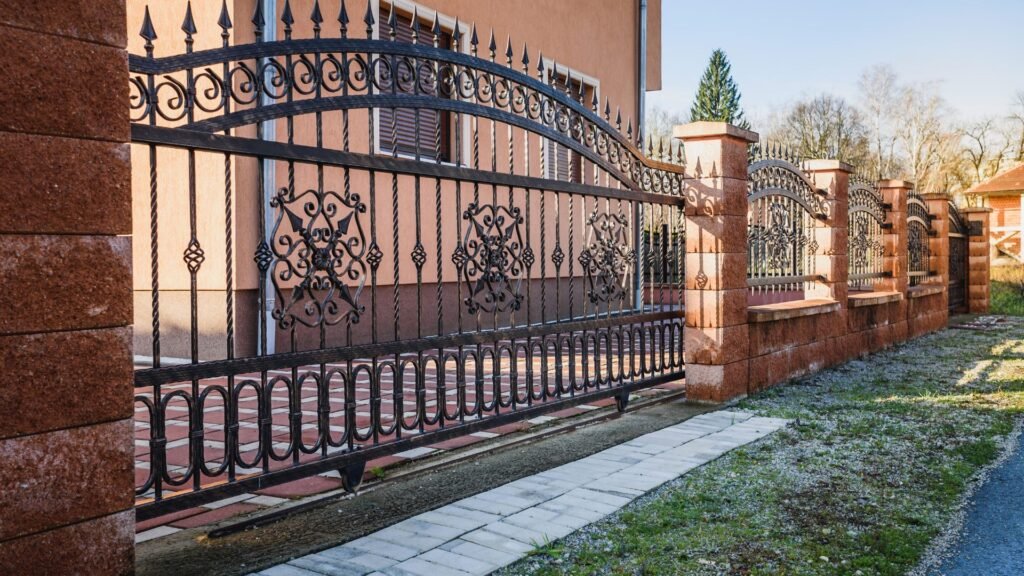
DIY Vs. Hiring A Professional
When it comes to installing a gate for your property, deciding whether to take on the project yourself (DIY) or hire a professional can be a tough choice. Both options come with their own set of advantages and drawbacks. Understanding when it makes sense to go DIY and when it’s better to rely on an expert will help you make a decision that aligns with your needs, budget, and long-term goals.
When DIY Makes Sense
There are certainly situations where installing a gate on your own can be a good option, especially for simpler gate types that don’t require advanced technology or heavy-duty equipment.
- Simple Gate Installations: If you’re planning to install a standard, manual gate—one that doesn’t require complex features like automation, intercom systems, or custom designs—then DIY may be a viable route. A straightforward wooden or chain-link gate, for example, can often be handled with basic tools and skills.
- Tools and Skills Needed: Before diving into a DIY project, it’s crucial to assess whether you have the right tools and the necessary skills. Basic gate installations may require tools like a posthole digger, concrete mix, a level, and basic carpentry tools. If you’re comfortable working with these, a DIY gate installation could save you money and give you the satisfaction of completing the project yourself.
- Risks of Improper Installation: However, it’s important to consider the risks associated with doing the job yourself. Poor installation can lead to gates that don’t function properly, causing issues with security or ease of use. In the worst-case scenario, improper installation can result in the gate sagging, malfunctioning, or even becoming a safety hazard. This can lead to costly repairs down the road, wiping out any savings you may have initially achieved.
Benefits of Hiring a Professional
For more complex gate installations, or when you want to ensure the highest quality and longevity, hiring a professional is often the smarter choice.
- Expert Installation for Large or Complex Gates: Gates that are made of heavy materials such as iron, or those that include automation features (like electric openers or security systems), require a level of expertise that goes beyond basic DIY skills. Professionals are experienced in handling intricate installations, ensuring that the gate is not only securely in place but also functions smoothly over the long term.
- Assurance of Warranties and Adherence to Local Regulations: One of the major benefits of hiring a professional is that many offer warranties on their work. This means if something goes wrong, you’re covered. Additionally, professionals are knowledgeable about local building codes and regulations, ensuring that your gate installation is compliant with all necessary rules. This can help avoid fines or the need to redo the installation later.
- Long-Term Savings Through Professional Expertise: While hiring a professional may have a higher upfront cost compared to a DIY project, it often leads to long-term savings. A professionally installed gate is less likely to encounter problems due to faulty installation, meaning you won’t need frequent repairs or adjustments. Moreover, pros have access to higher-quality materials and tools, ensuring your gate lasts longer and performs better.
Deciding between a DIY gate installation and hiring a professional depends largely on the complexity of the project and your personal skills. For simple, manual gates, DIY can be a cost-effective option if you’re confident in your abilities. But for larger, more complex installations, investing in a professional can offer peace of mind, durability, and long-term savings. Regardless of your choice, proper planning and understanding the scope of the project are key to a successful gate installation.
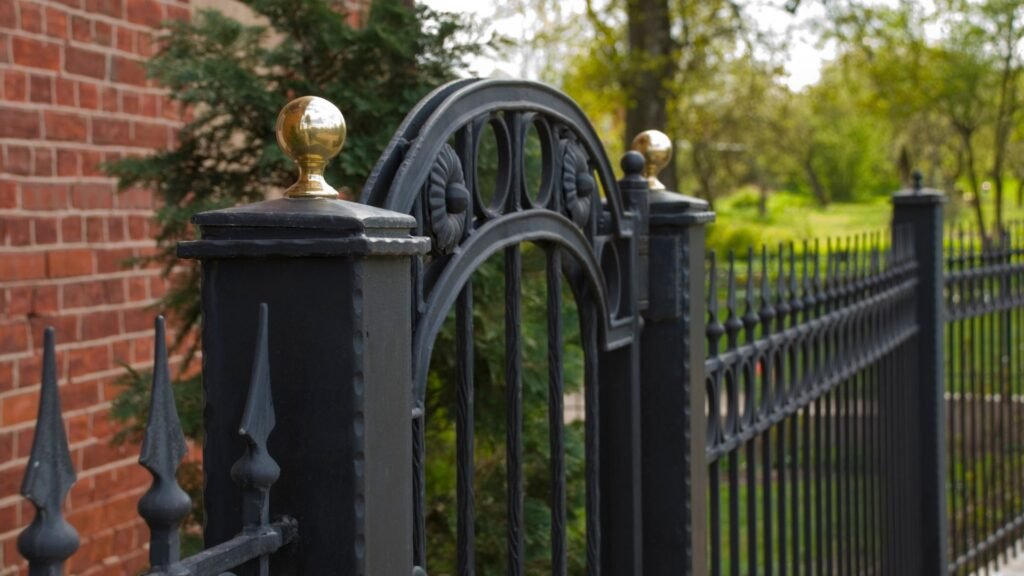
Common Mistakes To Avoid When Installing A Fence Gate
Installing a fence gate might seem straightforward, but it’s easy to make mistakes that can lead to bigger problems down the road. To ensure your gate installation goes smoothly and lasts for years, it’s important to avoid these common pitfalls.
Choosing the Wrong Material for Your Climate
One of the biggest mistakes people make when installing a fence gate is selecting the wrong material for their local climate. Different materials perform better in certain environments. For instance, wood gates can look beautiful, but they’re not always the best option for humid or rainy climates. Wood tends to absorb moisture, leading to swelling, warping, or rotting over time if not properly treated or maintained. On the other hand, metal gates might seem like a durable option, but if you live in an area prone to heavy rainfall or salty air (like coastal regions), metal gates can rust and deteriorate quickly without the right protective coating. It’s crucial to select a material that can withstand your local weather conditions, whether that’s wood, metal, or even vinyl.
Improper Measurements
Another common mistake is not taking accurate measurements before installing the gate. When measurements are incorrect, you may end up with a gate that doesn’t fit properly. A gate that’s too wide or too narrow for the space can lead to several issues: it may not close securely, it can sag over time, or you could be left with unsightly gaps that compromise the privacy or security of your fence. Taking careful, precise measurements—accounting for things like the width of the posts and the type of hinges used—is essential for a properly fitting gate. Always double-check your measurements before you start installing to avoid costly mistakes.
Skipping Permits
It might be tempting to skip the permit process to save time and money, but this is a mistake that can come back to haunt you. Many local governments have regulations regarding the installation of fence gates, particularly in terms of height, location, and material. Failing to obtain the necessary permits can result in fines, forced removal, or having to redo the entire installation to meet local codes. To avoid legal headaches, always check with your city or county’s building department to see if a permit is required for your specific project.
Ignoring Maintenance Costs
One factor that’s often overlooked when installing a fence gate is the ongoing maintenance it requires. All gates, regardless of the material, will need some level of upkeep over the years. Wood gates, for example, need regular sealing or staining to protect them from moisture and UV damage, while metal gates may need periodic painting or rust prevention treatments. Even motorized gates, while convenient, come with their own set of maintenance costs, such as repairs for the motor or electrical components. Before choosing a gate material or design, it’s essential to factor in the long-term maintenance and ensure it aligns with your budget and ability to keep up with the necessary care.
By avoiding these common mistakes—selecting the right material for your climate, taking proper measurements, securing the necessary permits, and considering ongoing maintenance—you’ll ensure your fence gate is both functional and long-lasting. Taking the time to plan and prepare for these potential issues can save you from unnecessary headaches and expenses in the future.
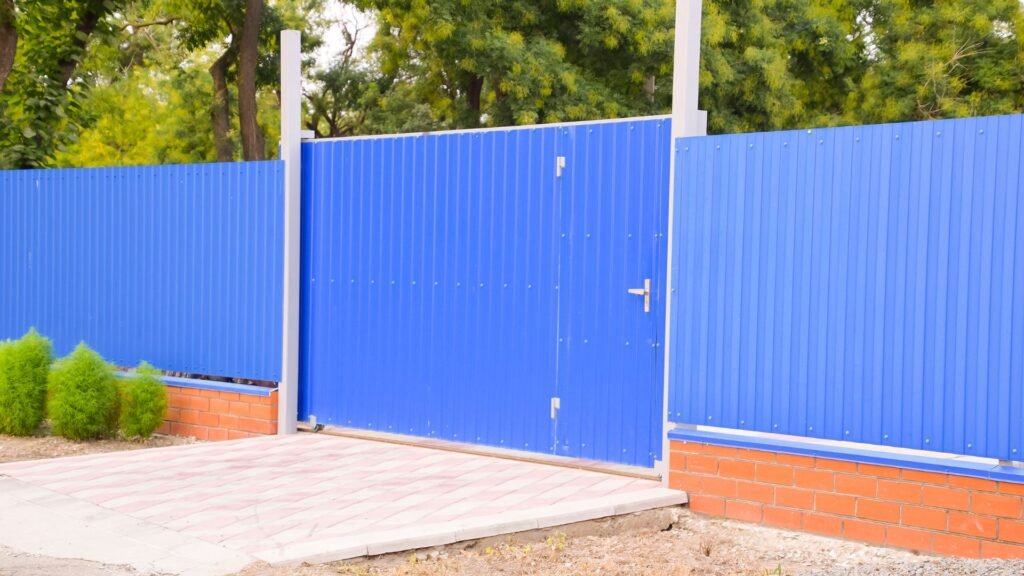
FAQs: About How Much Does It Cost To Install A Fence Gate
What is the average cost to install a fence gate?
On average, the cost to install a fence gate ranges from $200 to $4,000, depending on the material, size, and installation type. Basic gates, like chain-link, can be as affordable as $50, while high-end gates, such as wrought iron or automated gates, can cost $7,000 or more.
What factors affect the cost of a fence gate installation?
Several factors influence the cost, including the material (wood, metal, vinyl, chain-link), size and style of the gate, whether the gate is single or double, labor costs in your area, ground conditions, and any additional features like automation.
How much does labor cost for fence gate installation?
Labor costs for fence gate installation typically range from $30 to $75 per hour, depending on your location and the complexity of the project. More complicated installations, such as automated or custom-designed gates, may require higher labor fees.
Can I save money by installing the fence gate myself?
Yes, you can save on labor costs by installing the fence gate yourself, especially for simpler designs like chain-link or basic wood gates. However, professional installation is recommended for more complex gates, such as heavy metal or automated gates, to ensure proper fitting and safety.
What types of fence gate materials are available, and how do they impact cost?
Common materials include wood, metal (iron, aluminum, steel), vinyl, and chain-link. Wood and vinyl gates typically cost between $100 and $2,000 depending on size and design, while metal gates range from $200 to $4,000 or more. Chain-link gates are the most affordable, usually priced between $50 and $400.
Are there additional costs for automated fence gates?
Yes, installing an automated gate comes with additional costs. Basic motorized systems can start around $850 and go up to $5,000 or more, depending on the complexity of the system. You may also need to budget for wiring, sensors, and ongoing maintenance.
Do I need a permit to install a fence gate?
In many areas, a permit is required for fence gate installations, especially if the gate is large, motorized, or part of a new fence installation. Permit costs can range from $50 to $200, depending on your location. Always check local regulations before starting the project.
How long does it take to install a fence gate?
The installation time depends on the complexity of the gate and site conditions. A simple gate may take a few hours to a day to install, while a larger or automated gate can take several days due to the additional steps like electrical wiring and testing.
How can I maintain a fence gate to ensure longevity?
Maintenance depends on the gate material. Wood gates require regular staining or sealing to prevent weather damage, while metal gates may need periodic rust prevention and painting. Automated gates also need regular servicing of mechanical components to ensure smooth operation.
What are the common mistakes to avoid when installing a fence gate?
Common mistakes include choosing the wrong material for your climate (e.g., wood in humid areas), not measuring properly, skipping local permit requirements, and ignoring ongoing maintenance costs. Hiring a professional installer can help avoid these pitfalls, especially for complex or motorized gates.
Conclusion
In conclusion, the cost of installing a fence gate can vary widely based on several factors such as the type of material, the size of the gate, labor costs, and any additional automation features. When planning your project, it’s essential to consider both your budget and your specific needs, whether that be for security, enhancing curb appeal, or overall functionality. To ensure you make the best decision, it’s a good idea to request quotes from professionals and carefully evaluate your options. Whether you choose to install the gate yourself or hire an expert, the ultimate goal is to create a durable, visually appealing, and functional entrance that meets your requirements.
About the Author:
Mike Veail is a recognized digital marketing expert with over 6 years of experience in helping tradespeople and small businesses thrive online. A former quantity surveyor, Mike combines deep industry knowledge with hands-on expertise in SEO and Google Ads. His marketing strategies are tailored to the specific needs of the trades sector, helping businesses increase visibility and generate more leads through proven, ethical methods.
Mike has successfully partnered with numerous companies, establishing a track record of delivering measurable results. His work has been featured across various platforms that showcase his expertise in lead generation and online marketing for the trades sector.
Learn more about Mike's experience and services at https://theleadguy.online or follow him on social media:



